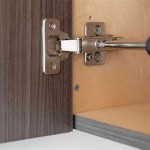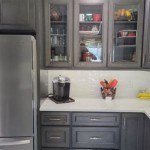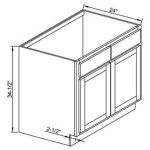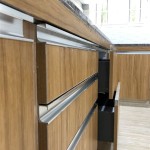```html
What Is The Best Way To Clean Kitchen Cabinets?
Maintaining clean kitchen cabinets is essential for both hygiene and aesthetics. Grease, grime, dust, and food splatters accumulate over time, impacting the appearance of the cabinets and potentially harboring bacteria. The optimal cleaning method depends on the cabinet material, the type of soiling, and the desired level of cleaning depth. This article outlines various approaches, emphasizing effective techniques and safe practices for achieving a spotless and well-maintained kitchen cabinet surface.
The first step in any cabinet cleaning process is identifying the cabinet material. Common materials include wood (painted, stained, or lacquered), laminate, metal, and glass. Each material reacts differently to cleaning agents. Using the wrong cleaner can damage the finish, causing discoloration, peeling, or permanent marking. Similarly, the types of soiling should be considered. Light dust and fingerprints require a gentler approach than accumulated grease or stubborn food stains.
Before applying any cleaning solution, it is crucial to test the cleaner on an inconspicuous area of the cabinet, such as inside a cabinet door or on a lower panel. This allows for observation of any adverse reactions, like discoloration or finish damage, before widespread application. Always allow the test area to dry completely before assessing the results. This preventative measure can save significant time and effort in rectifying potential damage.
Preparing for Cabinet Cleaning: Gathering Supplies and Safety Measures
Proper preparation is paramount for efficient and safe cabinet cleaning. The necessary supplies typically include: cleaning solutions (specific to the cabinet material and type of soiling), soft cloths or microfiber cloths, a soft-bristled brush (for textured surfaces or crevices), warm water, a spray bottle (optional, for applying cleaning solutions), dish soap (for general cleaning), baking soda (for abrasive cleaning), white vinegar (for removing grease and grime), and a non-abrasive sponge.
Safety measures are equally important. When using commercially available cleaning products, always read and follow the manufacturer's instructions. Ensure adequate ventilation in the kitchen by opening windows or turning on the exhaust fan. Wear gloves to protect hands from harsh chemicals or prolonged exposure to cleaning solutions. If dealing with mold or mildew, consider wearing a mask to prevent inhalation of spores.
Emptying the cabinets is generally not necessary for basic cleaning unless there are spills or stains inside. However, removing items from the countertops and nearby surfaces provides easier access to the cabinets and prevents accidental damage or contamination. Covering the countertop beneath the cabinets with a towel or drop cloth can also protect it from spills and drips during the cleaning process.
General Cleaning Methods for Kitchen Cabinets
For everyday cleaning and maintenance, a simple solution of warm water and dish soap is often sufficient. Mix a small amount of dish soap into a bucket of warm water. Dip a soft cloth into the soapy water, wring it out thoroughly, and wipe down the cabinet surfaces. Avoid using excessive water, as it can seep into seams and cause damage. After wiping with the soapy water, rinse the cabinets with a clean, damp cloth to remove any soap residue. Finally, dry the cabinets with a clean, dry cloth to prevent water spots.
Microfiber cloths are particularly effective for cleaning cabinets as they trap dust and dirt without scratching the surface. They are also highly absorbent, reducing the amount of water needed for cleaning. When using microfiber cloths, ensure they are clean and free of debris to avoid transferring dirt back onto the cabinets.
For cabinets with textured surfaces or intricate detailing, a soft-bristled brush can be used to reach into crevices and remove accumulated dirt. Dip the brush into the soapy water and gently scrub the affected areas. Rinse thoroughly with a damp cloth and dry. Pay attention to corners, edges, and areas around knobs and handles, as these tend to accumulate more dirt.
Addressing Stubborn Stains and Grease
Grease and stubborn stains require a more targeted approach. A solution of baking soda and water can be effective for removing these types of soiling. Create a paste of baking soda and water, ensuring it is not too abrasive. Apply the paste to the stained area and gently scrub with a soft cloth or sponge. Rinse thoroughly with a damp cloth and dry. Baking soda's mild abrasive properties help to lift stains without damaging the cabinet finish.
White vinegar is another effective cleaning agent for removing grease and grime. Mix equal parts white vinegar and water in a spray bottle. Spray the solution onto the greasy areas and let it sit for a few minutes to loosen the grease. Wipe away the grease with a clean, damp cloth. Vinegar's acidity helps to cut through grease and dissolve mineral deposits. However, prolonged exposure to vinegar can damage certain finishes, so it's essential to test it in an inconspicuous area first and avoid leaving it on the surface for extended periods.
For particularly stubborn grease stains, consider using a commercial degreaser specifically designed for kitchen cabinets. Follow the manufacturer's instructions carefully and test the product in an inconspicuous area before applying it to the entire surface. Some degreasers can be harsh and may damage certain finishes, so it's crucial to choose a product that is compatible with the cabinet material.
Cleaning Specific Cabinet Materials
Wood Cabinets: Wood cabinets, whether painted, stained, or lacquered, require special care. Avoid using excessive water, as it can damage the wood and cause warping or swelling. When cleaning wood cabinets, use a mild soap and water solution and dry them thoroughly. For stained wood cabinets, consider using a wood cleaner or polish to maintain the finish and prevent drying. Avoid using abrasive cleaners or scrub brushes, as they can scratch the surface.
Laminate Cabinets: Laminate cabinets are generally easier to clean than wood cabinets. They are resistant to water and stains, making them a practical choice for kitchens. A simple soap and water solution is usually sufficient for cleaning laminate cabinets. For stubborn stains, a mild abrasive cleaner can be used. Avoid using harsh chemicals or solvents, as they can damage the laminate surface.
Metal Cabinets: Metal cabinets are durable and easy to clean. A soap and water solution is generally effective for removing dirt and grime. For stubborn stains, a mild abrasive cleaner can be used. Avoid using steel wool or other abrasive materials, as they can scratch the metal surface. To prevent rust, dry the cabinets thoroughly after cleaning.
Glass Cabinets: Glass cabinet doors require a different approach. Use a glass cleaner and a clean cloth or paper towel to wipe down the glass surfaces. Avoid spraying the cleaner directly onto the cabinet frame, as it can damage the finish. Instead, spray the cleaner onto the cloth and wipe the glass. For stubborn stains, a solution of vinegar and water can be used.
Preventative Measures and Regular Maintenance
Preventative measures can significantly reduce the frequency and intensity of cabinet cleaning. Wiping down the cabinets regularly, especially after cooking, can prevent grease and grime from accumulating. Using a range hood or exhaust fan while cooking helps to remove airborne grease and moisture, reducing the amount that settles on the cabinets.
Placing mats or rugs in front of the sink and stove can protect the cabinets from spills and splatters. Using cabinet liners can prevent stains and damage from occurring inside the cabinets. Regularly inspecting the cabinets for signs of damage, such as water damage or peeling paint, can allow for early intervention and prevent further deterioration.
Regularly cleaning the kitchen, including countertops and appliances, can also help to keep the cabinets clean. A clean kitchen environment reduces the likelihood of grease and grime transferring to the cabinets. By implementing these preventative measures and establishing a regular cleaning routine, kitchen cabinets can remain clean and well-maintained for years to come.
DIY Cleaning Solutions vs. Commercial Cleaners
The choice between DIY cleaning solutions and commercial cleaners often depends on personal preference, budget, and the severity of the soiling. DIY solutions, such as soap and water, baking soda paste, and vinegar solutions, are generally more environmentally friendly and cost-effective. They are also less likely to contain harsh chemicals that can damage the cabinet finish. However, DIY solutions may not be as effective for removing stubborn stains or grease.
Commercial cleaners are formulated to tackle specific types of soiling and may contain stronger cleaning agents. They can be more effective for removing stubborn stains and grease but may also be more expensive and potentially harmful to the environment or cabinet finish. When using commercial cleaners, it is crucial to choose products that are specifically designed for the cabinet material and to follow the manufacturer's instructions carefully.
Ultimately, the best approach is to assess the type of soiling and the cabinet material and to choose a cleaning solution that is both effective and safe. Testing any cleaning solution in an inconspicuous area before applying it to the entire surface is always recommended, regardless of whether it is a DIY solution or a commercial cleaner.
```
How To Clean White Kitchen Cabinets 3 Best Ways Avoid Abbotts At Home

How To Clean Kitchen Cabinets 9 Basics Bob Vila

How To Clean Your Kitchen Cabinets

How To Deep Clean Kitchen Cabinets And Keep Them Looking Gorgeous Everyday Skate

We Tried 5 Methods To Clean Greasy Wood Cabinets And The Winner Is Ridiculously Effective Kitchn Cleaning Kitchen

How To Clean Kitchen Cabinets Dianella Polishing

How To Clean Kitchen Cabinets Everyday Skate

3 Super Easy Ways To Clean White Kitchen Cabinets And Avoid

Clean Kitchen Cabinets Off With These Tips And Hints

How To Clean Kitchen Cabinets
Related Posts








